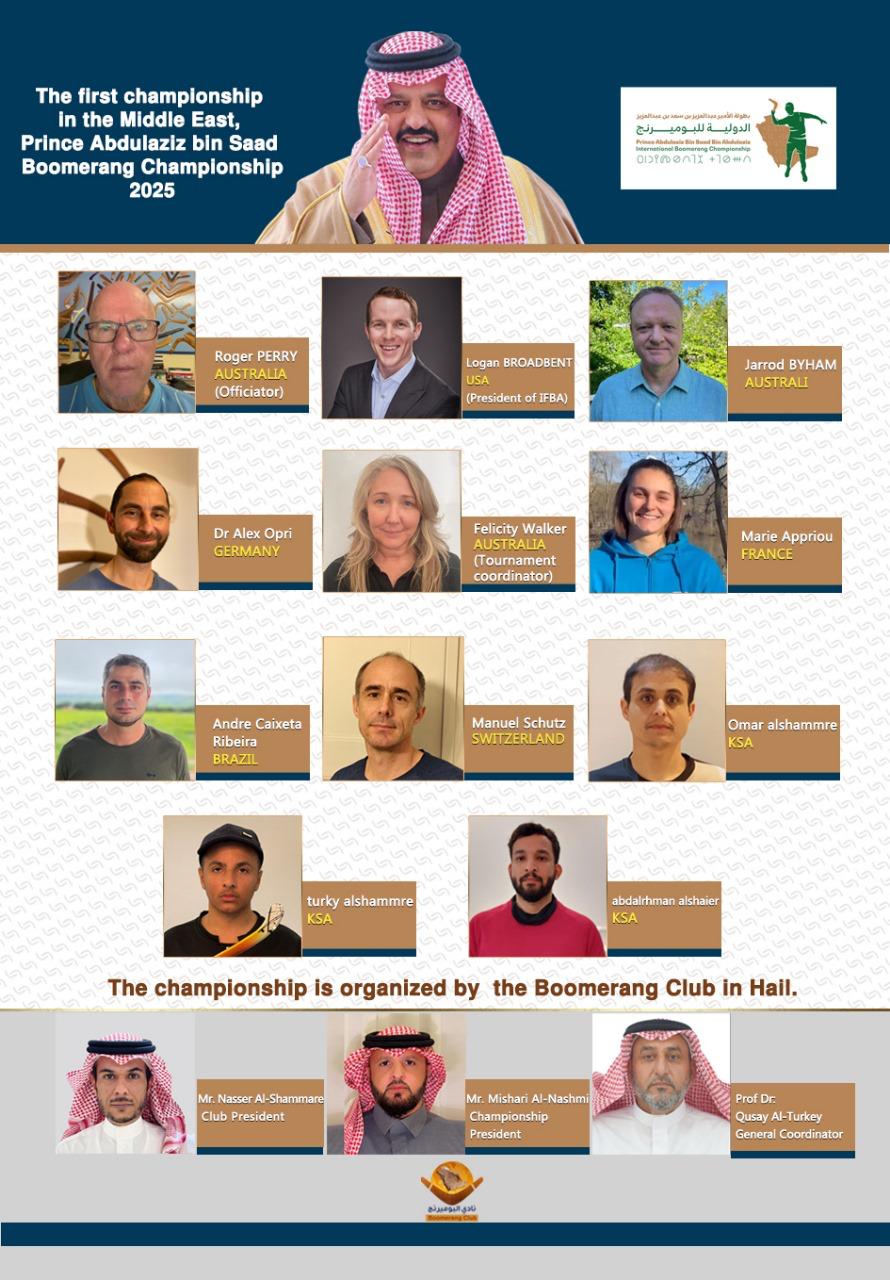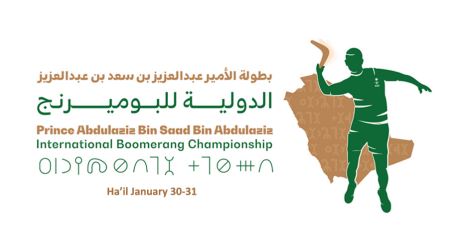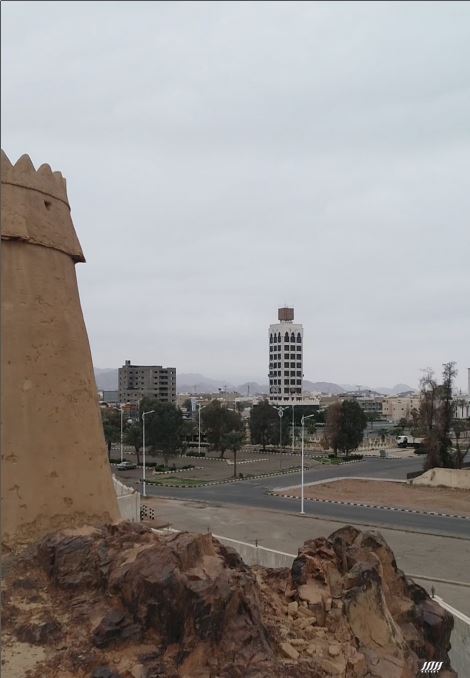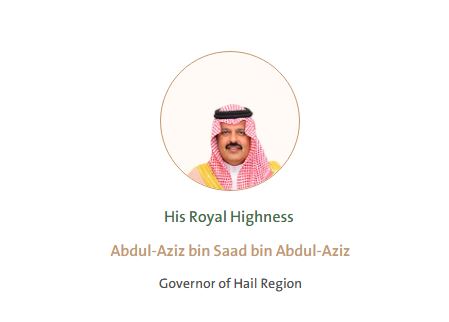The boomerang tool turned into a world sporting championship for the first time in the Middle East:
The idea of turning the discovery of the boomerang tool in Hail into a world sport was born when the subject was presented to His Highness the Emir of Hail Region, “Prince Abdulaziz bin Saad bin Abdulaziz Al- Saud”, as usual with his bright mind and sound vision, he pointed out to the President and members of the Boomerang Club in Hail the necessity for the Kingdom of Saudi Arabia to bring this international sport to the Middle East for the first time, by hosting an international championship in Ha’il.

The President and members of the Boomerang Club in Hail expressed their appreciation for this positive initiative, and planning began to hold the friendly world championship in Hail under the name Highness Prince Abdulaziz bin Saad bin Abdulaziz Championship“.

The dream has become a reality:

Under the direction of His Highness the Emir of Hail Region and with his direct support, the countdown has begun for the days of the International Boomerang Championship, which was adopted and supervised by the Hail Development Authority, which spared no effort to make this championship a success, considering it the first international championship to be held in the Middle East. Planning for the success of this championship was everyone’s goal and purpose, so that the flag of the Kingdom of Saudi Arabia would be flying high in all international fields and events. This championship was scheduled between the 30th of January and the 1st of February.

Discovery team and tournament supervisors
All programs and plans have been implemented to make the Prince “Abdulaziz bin Saad bin Abdulaziz Championship” a global championship worthy of His Highness’s name and the Kingdom of Saudi Arabia, which we are proud to be the pioneer and leader in the Arab world and the Middle East.

The championship team has drawn inspiration from the fact that the leadership and government of the Kingdom of Saudi Arabia seek to make the Kingdom the first in the world in taking the lead in organizing global sporting championships, and this is what happened and will happen in the Kingdom’s organization of the FIFA World Cup in 2034, under the patronage of creativity and development, His Highness Prince and Crown Prince Mohammed bin Salman, and under the high patronage of His Majesty the King Salman bin Abdulaziz Al Saud, Allah protect and preserve them.
The connection between the modern sport of Boomerang Throwing and the ancient rock art of the Hail region depicting these tools in use thousands of years ago, brings to life the profound link between us and our ancient ancestors before us.

Boomerang Club in Ha’il the first club in the Middle East

Highness Prince Abdulaziz bin Saud Boomerang Tournament Ha’il-

Prof Dr. Qusay Al-turkey

Mr. Mishari Abdulaziz Al-Nashmi

Mr. Nasser Mubarak Al-Shammari
Introduction:
The achievements and championships that the Kingdom of Saudi Arabia is achieving continue day after day with the remarkable development and progress that the Kingdom is witnessing under the auspices of the wise leadership of King Salman bin Abdulaziz, the inspiration of the East and the architect of the modern vision for the prosperous future of the Kingdom 2030, and the Crown Prince, His Highness Prince Mohammed bin Salman, may God protect and preserve them.

The tool turns into a world championship for the first time in the Middle East under the name of Highness Prince Abdulaziz bin Saad Al Saud:

Friendly International Boomerang Tournament Ha’il January 30-31/2025

One of the most important rock art scenes of the use of the boomerang tool from the city of Juba in Ha’il
Background Information about Discovery of the Tool in Saudi Arabia:
Evidence of the historical use of the tool called boomerang as a global name tool was discovered in the Hail region.
This distinctive tool is featured in rock art representing hunting scenes in the Hail region, specifically in the mountains called AL-Masma, Shuwaimis, Joba and Arnan (see map). Carvings of boomerangs of various shapes and uses were discovered in rock art. It was noted that the carvings of this tool closely resemble the famous boomerang tools of Australia.

Map showing the sites of boomerang in Ha’il region
A heritage researcher from the city of Hail, “Mishari Al-Nashmi”, became aware of this tool and learned its original information through his communication with the Saudi professor specializing in the archaeology of the Arabian Peninsula and the Arabian Gulf, “Qusay Al-Turkey who has been based in Australia for many years, information was gathered about the Australian boomerang tool.
It is worth noting that attempts to know the tool and understand its purpose had been referred to by a number of researchers and interested parties, as the anthropologist Eid Al-Yahya presented on his YouTube channel a scene of hunting a buffalo with a boomerang tool:
In fact, the tool in the Arabic language, it is known as the “Arm” tool or the “Hadhf”(حذف) tool, and worldwide in Australia, America and Europe, it is known as the boomerang tool and is recognised worldwide as a symbol of the cultural heritage of the indigenous people of Australia.
With the support of the Emirate of Ha’il Region represented by Royal Highness Prince Abdulaziz bin Saad Al Saud, further research into the world history of the boomerang tool led to the surprising discovery that boomerang throwing is an international sport requiring high levels of both technical and athletic skill.

Rock art drawings of various types of the Boomerang from Rata southern Ha’il
Boomerang tool in rock art from Ha’il:
Before the discovery of evidence of the existence of this tool in the Arabian Peninsula, specifically in the Kingdom of Saudi Arabia, it was believed that the original home of this tool was Australia and America, where the oldest evidence of use this tool archaeologically, dates likely to 10 thousand years ago. However, the discovery of multiple boomerang models in the Hail Mountains region in distinctive rock drawings, clearly indicates the knowledge of the inhabitants of the Arabian Peninsula of this tool from an early time. Researcher Mishari Al-Nashmi has referred to this tool in his writings, comparing it to existing hunting tools outside the Kingdom of Saudi Arabia (Mishari Abdulaziz Al-Nashmi, 2022, p. 112).

This rock art scene in Al-Qawr/ Ha’il, shows the boomerang tool being used creatively for hunting
Purposes of using the boomerang:
With the repeated discovery of models of the boomerang, whether the arm tool or its various forms in Europe, Australia or the Kingdom of Saudi Arabia, it appears that various forms of this tool were used for several purposes within the culture of ancient societies. Various uses evidently demanded a range of shapes, designs and sizes according to each purpose (hunting, games, music, digging to place grains, etc.). These designs and functions were not necessarily transferred from one people to another, but perhaps made locally within their regions – with similar ideas, purposes and goals. It is likely that the models discovered in the Hail region are the most and oldest historically in the Arabian Peninsula to this day, especially artistic scenes of hunting deer using a hunter’s stick, as is clear from the site of Rata rock art.

One of the most famous scenes of boomerang hunting in Rata / Ha’il
The name for boomerang:
“Boomerang” is an English term coined by European as an ancient hunting tool for the indigenous people of Australia. The term was first documented in 1822 and was recorded with three phonemes “bou-mar-rang”, or from “wo-mur-rang” and the name is apparently taken from the Dharuk language of one of the Australian indigenous tribes; the Turuwal people. Studies indicate that the term “boomerang” in terms of name varies from place to place across the Australian continent and the world.
The ancient Arabic name for the boomerang:
Through the increasing number of discoveries of multi-purpose boomerang drawings, it is suggested that its original home was the Arabian Peninsula in the ancient Near East, and that the general basis for using this tool was mostly for hunting, and evidence of that is what we found of the use of the tool in hunting scenes with a bow and arrow (hunting scenes in the rock drawings in Ha’il), in addition to what the user of the tool wears of a mask covering the entire head, which was in the shape of a bird’s head. This purpose (killing and hunting prey) was extended to the linguistic term by which the arm tool was named in the civilization of the Arabian Peninsula, as the word appeared in linguistic dictionaries specializing in cuneiform writings since the end of the fourth millennium BC, indicating verbally and pictorially the act of “killing” and fighting, and using the correct letters of the Arabic word “Qital”(قتل – صيد) which means hunting, and in the form “Taqntu/Taqttu” (tuquntu/tuquttu) of the word in the Akkadian language (one of the most important Arabic mother tongues), noting that the description of the tool itself in the Sumerian language was preceded by the name indicating things made of wood (giš LAL), so it is a wooden tool (Labat R, 2002, no. 481). What confirms and we have said, that its origins are from the Arabian Peninsula, is that the pictorial form in the most important linguistic dictionaries also matches the form of the tool from the beginning of its manufacture until today in the cuneiform pictorial sign and its development into a verbal syllabic sign.

The pictorial sign in cuneiform writings for the arm tool in the oldest written writings in the world
The oldest physical evidence of the boomerang tool:
Archaeological evidence indicates the discovery of the boomerang in many places in the world, but it is few in number compared to the models available in rock drawings in the Kingdom of Saudi Arabia. Carbon 14 radiometric dating has proven the date of the oldest boomerang tool discovered so far, with the discovery of a retracted boomerang in South Australia, a model found during archaeological excavations conducted by archaeologist Robert Lubbers in the South Australian in Wyrie Swamp area, and its date was estimated to be around 9,000 years ago. The author Philip Jones published a book called “Boomerang” in which he explains the history of the tool (Philip J, 2004, p. 10).


The oldest boomerang tool discovered in archaeological excavations in Australia
The oldest evidence of the boomerang tool in rock drawings in the Kingdom of Saudi Arabia:
As for the history of recent discoveries of rock drawings in the Ha’il region, the technical evidence of the tools clearly indicates that the history of the boomerang tool discovered on rock faces by the Boomerang Club in various areas of the Ha’il region is likely to be the oldest as the degree of the painting depicts the hunter using the boomerang tool for hunting in ancient Near In the scene, we find a group of hunters with their slender bodies, and next to them are hunting animals such as livestock. They are wearing a special mask and carrying a hunting stick (boomerang).

The boomerang tool in various shapes and purposes in an artistic scene in Al-Qawr, south of Ha’il
As for the most widespread artistic scenes discovered in Hail, we find them repeating the scene of hunting birds. The discovery team noticed that the process of using this type of boomerang tool to hunt birds was characterized by the hunter wearing a mask covering his head and neck. This mask is usually a bird’s head with long bird feathers attached to it from behind, in order to delude the prey of birds and others that the moving body towards the prey is a bird as well. This is what we found in one of the murals in the Ha’il region, where we find the hunter wearing a mask in the shape of a bird’s head. As for the other artistic scene, we find the hunter wearing a rectangular mask resembling the head of an ibex.

The bird mask and the ibex mask worn by the hunter in a rock drawing from Ha’il
References:
- McCarthy, F.D (1961) The Boomerang, Australian Museum Magazine, Paperback Extracted from: The Australian Museum Magazine, Vol. XIII, No. 11, Sept, pp343-349.
- Labat R, (2002)’Manuel D Épigraphie Akkadienne,’6 edits, Paris.
- Philip Jones,(2004), Boomerang: Behind an Australian Icon, Published by Wakefield Press, Adelaide, South Australia.
مشاري عبدالعزيز النشمي، الابل العربية في الرسوم الصخرية، تقديم سليمان الذييب، دار المفردات للنشر، الرياض: 2022














More Stories
Youth Engaged in Radio Programs to discuss Critical Issues of Corruption
Young Women Drilled In Essential Mobile Journalism (MoJo) Skills
The People First Foundation (PFF) – A Community Centred Charity Institution